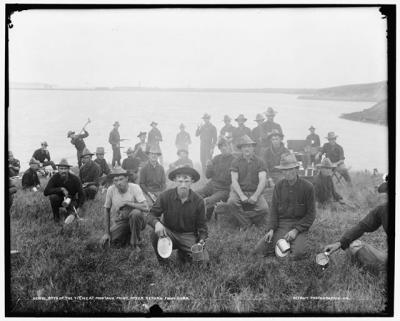Talk on Montauk’s Camp Wikoff

It has never been confirmed that Spain blew up the U.S.S. Maine on Feb. 15, 1898, but the explosion that killed more than half the American battleship’s officers and crew members as it sat in Havana Harbor set off the Spanish-American War.
The war marked the first time that American soldiers were sent overseas to fight, and many would die in Cuba of tropical diseases such as yellow fever, typhoid, malaria, and dysentery. Looking for a site on the Northeast coast of this country that could accommodate between 22,000 and 29,000 sick troops, Secretary of War Russell Alger chose 5,000-plus acres in Montauk as an ideal place to quarantine soldiers while they convalesced. It was named Camp Wikoff after the first United States officer killed in the Spanish-American War.
Jeff Heatley and Richard Barons will speak about Camp Wikoff and both its East End and national impact at Clinton Academy on Friday, March 23, at 7 p.m. Their talk, “Fever in Montauk: Camp Wikoff and the East Hampton Community,” is the last in the East Hampton Historical Society’s winter series “Doctors, Housecalls, and Hospitals: Keeping Well in Old East Hampton.” It will be preceded by refreshments at 6:30.
Mr. Heatley edited “Bully! Colonel Theodore Roosevelt, the Rough Riders & Camp Wikoff,” a compilation of 1898 newspaper articles on the war and its aftermath here, with help from the late Russell Drumm and the Montauk Historical Society. “Bully!”, published in 1998, details the quarantining of the 5th Army Corps in Montauk, including many of Teddy Roosevelt’s Rough Riders and sick soldiers who had been waiting at Army posts in the South to be shipped out to Cuba. Mr. Heatley said that one of the reasons he did the book was that “the journalism from newspapers of the 1890s . . . was stunning.”
Aside from the climate and relative isolation, what also helped seal Alger’s decision on Camp Wikoff’s location was the extension three years earlier of the railroad to Montauk. South Fork residents were not happy at the prospect of so many sick men convalescing in Montauk, however. Many young women from both forks received training from the Red Cross to be able to nurse the soldiers; some of these women got sick and some died.
In the end, 350 soldiers died in Montauk, some of starvation because once they became really ill, they could not digest the rations given them and because of red tape, the food they might have been able to eat, such as eggs, milk, chicken, and fresh vegetables, did not get there in time, Mr. Heatley explained recently. By the end of August 1898, there were 20,000 men in the camp, 2,100 of them in hospitals.
The talk by Mr. Heatley and Mr. Barons is free.
